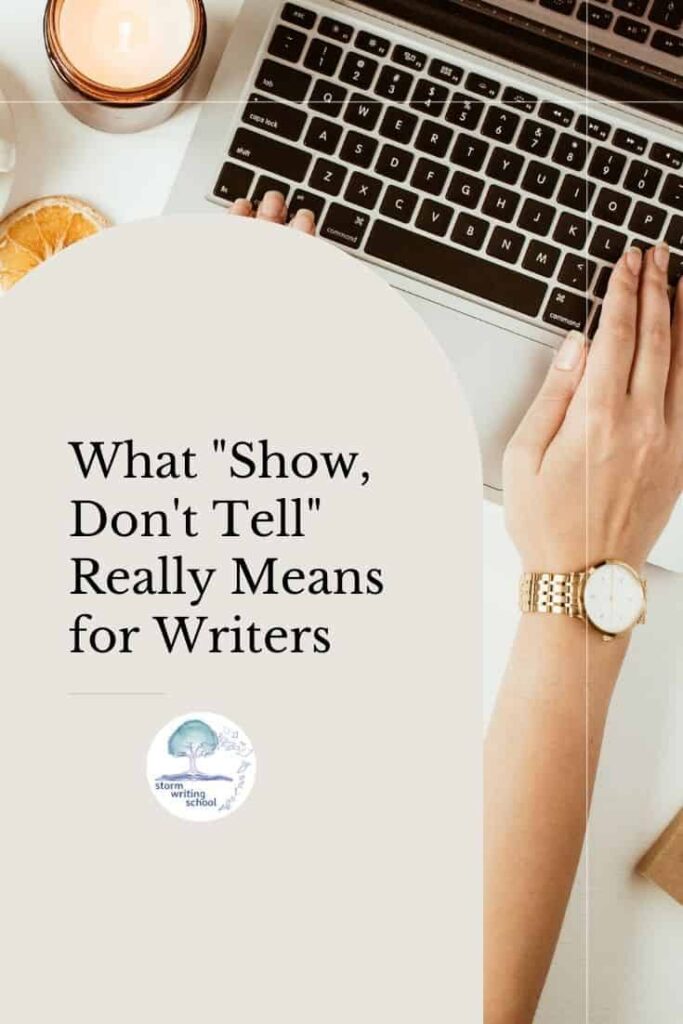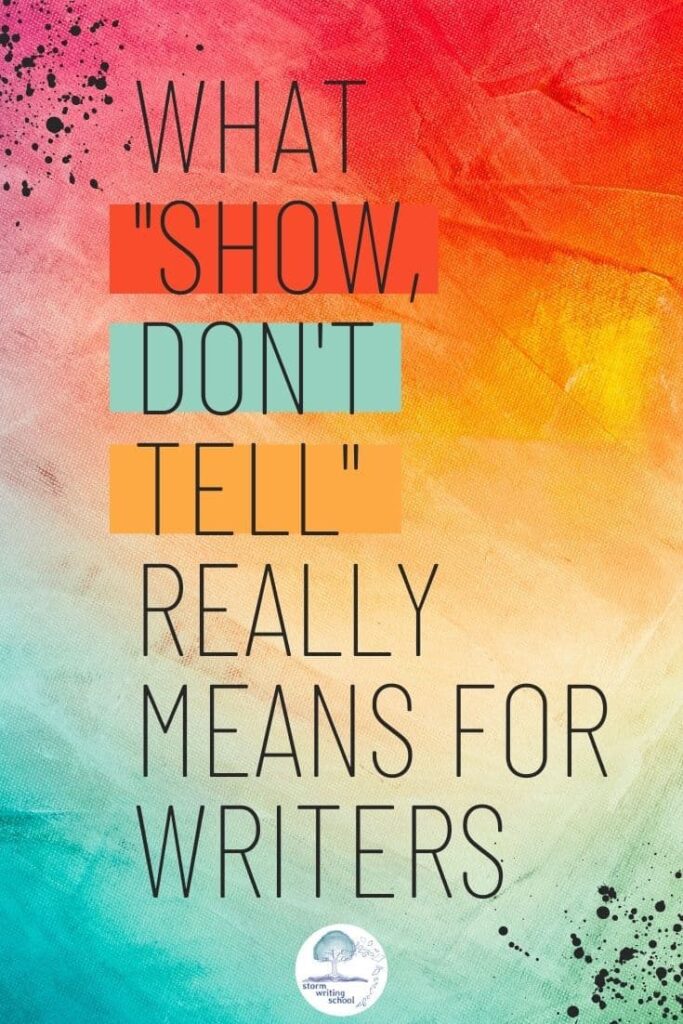Show, don’t tell. It’s a piece of writing advice that is nearly ubiquitous, especially among Western creative writing instruction. I maintain that 1) it’s a good skill to practice and master, 2) it’s not the only path to effective writing, 3) there are, in fact, some potential pitfalls to it, and 4) with its ubiquity comes an occasional lack of clarity about what the concept even means.
So I’d like to offer some disambiguation here.
What’s at the root of showing?
Readers like to be immersed in a piece of writing. And one method for achieving that immersion is to mimic real-life experience by presenting stimuli without an assessment of what those stimuli mean.
That’s how things are in our daily existence. We witness a woman watch a shirtless man jog past and then we see her eyes go wide as she clearly mouths, “Wow!” We see a couple in the front seats of a car shouting at each other and gesticulating with furrowed brows. We see a man on a park bench smiling as he watches a toddler place her hands over her eyes and then pull her hands away quickly and giggle.
Humans are social creatures. We have mirror neurons, which enable us—indeed, even compel us—to see situations like the ones above and guess at what people are feeling.
I often say that readers want to do a certain kind of mental work. They want the chance to solve mysteries. They want to be proud of their own cleverness when they piece together 2+2. They want to speculate about character motivations and feelings. They want to co-create the story with their own imaginations.
And that’s what showing is. It’s about the writer stepping back from their own impulse to make sense of things and letting the reader do that work. It allows for immersion and inference; those two concepts are at the heart of showing.
Most writers want to be good at such a skill.
What is being shown exactly?
This is an important point. Essentially, showing is about rendering the abstract concrete and specific.
Let’s back up a little. What is abstraction? Well, we might use abstractions to label, among other things,
- a person’s emotions (she was angry)
- their motives (he wanted revenge)
- the qualities of a person (he was attractive)
- the qualities of a place (the desert was cold at night)
- actions (they battled viciously for three days but lost)
- theme (the American dream is an unattainable fantasy)
But showing pushes us to depict specifics that will allow the reader to infer such abstraction. Chekhov is often credited with “inventing” the concept of “show, don’t tell,” and he provides a pretty good example of what is meant by depicting specifics that allow the reader to infer: “In descriptions of Nature one must seize on small details, grouping them so that when the reader closes his eyes he gets a picture. For instance, you’ll have a moonlit night if you write that on the mill dam a piece of glass from a broken bottle glittered like a bright little star, and that the black shadow of a dog or a wolf rolled past like a ball.”
Can’t you just write “moonlit night” on occasion?
Of course. One type of showing is about the qualities or attributes of a person, place, or thing. This tends to be more surface-level stuff, arising from sensory detail. But another type is deeper and has to do with feeling, emotion, meaning.
Fairy tales are famously shy on the level of specificity that Chekhov calls for, but that’s not a failing. Through their often-abstract, often-summarized narratives, fairy tales juxtapose strange occurences that get us doing a different kind of reader work than visualizing a place or a person.
A girl arrives at her grandmother’s house and finds a strange simulacrum of her grandmother in bed—a wolf, it turns out, who wants to prey upon the girl but does not use the much more effective method of ambushing the girl in the forest and going straight for the throat. What’s that all about? The reader has to do the work.
So something is still shown. It’s just that the shown abstraction is on a different level.
What do people mean by “Show, Don’t Tell”?
“Show, Don’t Tell” sets up a dichotomy: this vs. that. Some people think of that dichotomy as being roughly equivalent to scene vs. summary. Some people think of it as being concreteness vs. abstraction. Some think of it more as action vs. information. Some think of it as implying vs. explaining.
I would argue that all of these are right, but maybe none are complete. Showing incorporates scene, concreteness, action, and implication. Telling includes summary, abstraction, information, and explanation.
And honestly, it’s probably more of a Venn diagram with overlap than two distinct circles since often when you “tell” something, you’re showing something else.

How do writers show?
We can hearken back to Chekhov’s explanation of showing and assert that when it comes to actual sentence craft, the show/tell spectrum comes down to level of detail. More detail = showing; less detail = telling.
Indeed, we could take any sentence and make it either more specific (adding increasing levels of detail) or more general (subtracting detail). We can achieve greater detail through some of the following methods:
- Employing strong, specific verbs (maybe “saunter” rather than “walk”)
- Incorporating specific nouns (“car” becomes “Corvette”; “street” becomes “Grand Avenue”)
- Appealing to the senses (details that relay sight, sound, smell, and sometimes taste or feel)
- Including concretes instead of abstractions
- Minimizing adjectives and adverbs that assess for the reader
- Using comparisons (analogy, metaphor, simile)
But as our fairy tale example illustrates, that second type of showing comes not from more detail but from arrangement.
Painting serves as a nice analogy. Not every piece needs to be photorealistic. Abstract expressionism and impressionism are valid forms that still convey emotion and meaning, and sometimes do so even better than photorealism. You can have thicker and less careful brushstrokes but still create meaning via the placement of shape and color.

So in short, writers show either via detail or via structure/arrangement. But I’ll admit that “Show, Don’t Tell” is conventionally understood to be about detail and concreteness.
How do writers abuse showing?
If you’re like me, you looked at the list of methods above and thought of all the ways writers take those very techniques and push them so far that the writing becomes overstuffed, unnecessarily flowery, or just boring.
Not every piece of a story is deserving of attention and specificity. If the tale is about a little girl visiting her grandmother only to find a wolf in the grandmother’s bed, we may not need to know what the cottage was made of, whether the forest was deciduous, what kinds of insects buzzed through the air, what was in the grandmother’s medicine cabinet, or even what series of facial expressions the little girl made as she entered the cottage and found a stranger in her grandmother’s bed.
I see some of the following problems arise from an attempt to show rather than tell:
- Hyperdetailing (sharing excessive detail; not filtering for significance)
- Telegraphing (not trusting reader’s ability to intuit via concrete detail and thus intruding with even more details and/or explanation)
- Overdoing expressions and physical gestures (attempting to detail every physical response of the characters as if describing a film)
- Providing too much description of character appearance and clothing
- Making scenes out of transitionary pieces of the story
Is there anything that, I don’t know, maybe undermines all of this?
Yeah, kind of. Voice.
In the name of voice, you can do anything you want in writing. You can hyperdetail if you want. You can use abstractions and judgment. You can telegraph and use cliches. You can attempt to steal all the work from the reader.
But then you’re not really undermining showing, are you? You’re just shifting the showing to a different object—the viewpoint character. The reader is still doing the work of evaluating the viewpoint of the person who seems to be breaking all these so-called rules.
Ultimately, I think it’s important for writers to know some of the ins and outs of what constitutes showing vs. telling. But I like what my colleague Louise Harnby has said. It’s not “Show, Don’t Tell” that we should be promoting; it’s “Show and Tell.” I find the whole conversation around showing and telling to be more productive when it’s not framed as a prescription but is, rather, a description of what effect these two broad techniques have on readers.








5 Responses
At the risk of sounding like Spock – this is fascinating! Thank you, Tim.
best wishes to you and yours,
Lita
Thanks, Tim. I liked this simple direction: “And that’s what showing is. It’s about the writer stepping back from their own impulse to make sense of things and allow the reader to do that work.” In reading others’ work, I see that authors often don’t trust the reader, or themselves, to make sense of what’s subtle, but obvious to the close reader.
It took me a long time to understand and then apply these concepts, and God only knows if I’ve been successful. Either way, it’s nice to get a thorough refresher (although not gonna lie, I had to look up the meaning of “disambiguation”) LOL!
I love this! My editor constantly wrote “show don’t tell” her comments and now I find myself second guessing every transition summary and exposition. Thank you for the clarification that will free my angst.
3. This post is excellent and helpful. I am a fan of Tim’s writing and happy to see it here. I might add as related to “show don’t tell” getting out of the way of the action. It is related to the passive voice in your POV and show don’t tell. For example, I get in the way of the action if I write: “Angelo felt his stomach drop. He remembered he left his knife at home.” Change it to “Angelo’s stomach dropped; his knife was at home.”